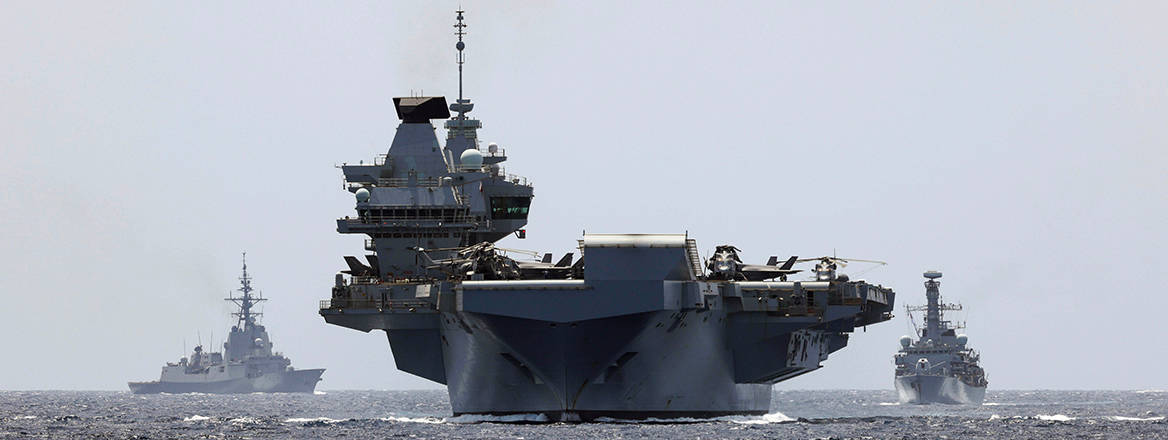Necessity of Evolution: CSG Deployment After Highmast
The primacy of the Russian threat to Europe may not eliminate the value of CSG deployments but in the future they should take a different form as dictated by the threat environment. The current emphasis on diplomacy might be better served by less operationally valuable assets.
HMS Prince of Wales and the Carrier Strike Group (CSG), under Operation Highmast, has now transited the Suez canal as intended. The group, including Norwegian, Canadian and Spanish vessels, will progress on to the Indo-Pacific region. The Royal Navy (RN) press release list of deployment aims includes reaffirming ‘the UK’s commitment to NATO’ and to ‘maintain international security and prosperity’. The line ‘international by design’ underscores the commitment to an internationally engaged UK. This deployment is part of the UK-France commitment to maintain European presence in the Indo-Pacific through coordinated carrier deployments; the French CSG having returned earlier this year.
Some may question the wisdom of such a deployment given the renewed focus on European defence. High-level statements from the USA have led some allies to question the extent to which the US can resource European commitments in a context where China is its pacing challenge. Additionally the US has intimated, including in a speech by the US Defence Secretary at the Shangri-La dialogues, an intent to re-focus on the Indo-Pacific region and a strong preference for Europe to take more responsibility for their own defence rather than trying to support the US further afield.
This shift in US focus coincides with a growing Russian threat in the Atlantic into the early 2030s as it takes delivery of further Yasen class submarines and several Akula class SSNs returning from refit. The RN is preparing to be able to counter Russian incursions from the north through the Bastion Atlantic and, although not an anti-submarine warfare (ASW) asset per se, aircraft carriers will serve to protect other ASW assets from air threat. Additionally, there are assessments that a properly resourced CSG in European waters would be the most valuable maritime contribution to a NATO conflict with Russia in Northern Europe. One might, therefore argue that NATO members should not become more militarily active in the Indo-Pacific.
Given the above, why is the RN, and allies, heading east? The twofold answer is that the UK trades, literally and figuratively, on its international voice and influence and the current moment represents a window of opportunity to showcase elements of a credible strike capability. Threat of conflict in Europe is assessed as being worryingly close but not imminent, leaving an opportunity for wide-ranging deployments like Highmast.
Long-range CSG deployments have an important role to play, but will likely need to be guided by narrower, better-defined objectives
While deployment of CSGs to the Indo-Pacific may retain value, future operations will need to be shaped by the prevalent threat and priorities at the time. This commentary examines what those future priorities might be. Its core argument is that, despite the benefits, the current deployment that convers numerous port visits and engagements in support of messaging, the prosperity agenda, and diplomatic outreach may be an unaffordable luxury in a future threat environment. Long-range CSG deployments have an important role to play, but will likely need to be guided by narrower, better-defined objectives. These should favour shorter operations targeting deeper engagement with a smaller group of core partners. The broader engagement tasks of the CSG may need to fall to other force elements, leaving the CSG to respond to the prevalent threat of the day, wherever it is found.
Deterring Global Russia: Expeditionary Activity in a Europe First World
The deterrent effect of Highmast in the Pacific vis China is likely limited, a view echoed by the US. The range limitations of the UK’s carrier borne aircraft, present lack of offensive munitions other than Paveway IV and the CSGs presently limited protection against threats such as the DF-17 make operating near the first island chain, an area where even the US Navy would initially struggle, highly unlikely.
However, there are regional scenarios in which China is not directly involved. Many are arguably closely linked to the Russian threat, which has a more global dimension than is acknowledged by many, who incorrectly dismiss Russia as a regional power. North Korean (DPRK) participation in the conflict in Ukraine has shown the links between Pacific and European security. Despite the limited military might of the European assets compared to those of the US, they can play an important role in areas which impact NATO but are not part of SACEURS area of operations. NATO’s vision for 2030 acknowledges that the Alliance’s defence increasingly has global dimensions and it requires mechanisms and tools to cope with Russia’s global aspirations; Highmast is just such a tool.
Indo-Pacific scenarios directly linked to Russia, not including a Sino-American clash, arguably make European expeditionary capacity, and signalling, of relevance. For example, in a clash on the Korean peninsula initiated by a DPRK that had elements of its military modernised by the Russians, particularly its air defences. Such a scenario would directly impact European security given the peninsula’s importance to many European states’ rearmament plans. While the US has considerable capability in theatre, much of this is likely to be focused on the PRC (which has led, for example, to troop withdrawals from Korea).
Additionally, though the US might be drawn into such a crisis, involvement beyond a certain level risks escalation vis China, as seen during the Korean war, in a way less applicable to European capabilities. The South Korean military may be independently capable of matching even an up-gunned North Korea. However, external support, for example in suppression of enemy air defences (SEAD), could be an area where Europe contributes. An expeditionary capability, such as that of the UK and France, could prove itself against a Russian ally in a manner that is additive to European security.
European presence in the Indo-Pacific deployments may also create uncertainty for Russia. General Gerasimov recently opined that NATO was spreading to the Pacific; while this might be viewed as posturing, concerns are backed with capability. For example, two of the five Yasen class SSGNs built thus far were allocated to the Pacific fleet, along with nuclear torpedo capable submarine Belgorod. As the ability to export hydrocarbons east via the northern sea route becomes more central to Russian economic planning in the next decade, the safety of both civilian and military infrastructure in the Russian far east will become more salient. NATO emerging in Russia’s Pacific rear areas could compel them to commit resources away from Europe, potentially easing the Atlantic threat.
The Importance of Deployments to Capability Generation
It is generally accepted that Russia will not be ready for conflict with NATO for some years after the culmination of conflict with Ukraine. This window is critical for improving capability and resilience and preparing for possible conflict. There is a naval and defence logic to deploying CSGs at reach. The task is one which stretches both navies and organisations such as PJHQ, forcing a stress test of both naval capacity and Whitehall’s mechanisms for cross-government coordination.
Shorter deployments focused on specific exercises with key partners could be more efficient and arguably more operationally relevant
Within the task group, tactical and operational procedures need to be developed, applied and tested building on lessons relearnt by CSG 21. Highmast is integrating the UK’s F35B Lighting without the US Marine Corps jets of CSG21, and working with accompanying allied ships continues to develop interoperability, a key demonstration of NATOs ability to deploy a coherent force package. Contact with both partner navies such as the Japanese (JMSDF) and competitors such as the PRC also provide opportunities to learn lessons. The deployment offers the opportunity for continued and deeper engagement with the US Navy’s carrier strike capability, building on the achievements of exercises such as Strike Warrior. The deployment is expected to allow the CSG and the UK’s F35B programme to declare Full Operational Capability. In principle, making one of the UK’s flagship capabilities ‘war ready’. However, in truth, most capability development benefits could be delivered by training in Europe.
Nonetheless, the UK can gain considerable mutual value from engagement with partners such as the JMSDF. For example, by supporting efforts to generate a STOVL air wing on its Izumo class destroyers. It also allows for leveraging partners’, including the US’s (Indo-Pacific Command), Japan’s and South Korea’s knowledge about the currently state of the art Chinese A2AD bubble which may resemble a future Russian anti-access capability in Europe.
However, if such training/exercising is the aim then the broad remit of Highmast, with multiple disparate visits, is arguably less useful than more focused engagement. Shorter deployments focused on specific exercises with key partners could be more efficient and arguably more operationally relevant. A CSG Pacific deployment might be followed by a JMSDF deployment to Europe where lessons from theatres such as the Baltic Sea, in a littoral environment comparable to the east China Sea, might be shared by both the UK and JEF partners. If the Atlantic Russian threat develops as feared the CSG may be less available for prolonged deployments, and it should be kept ready to respond to threat wherever it is found.
Support to Allies and International Commitments: Carriers are Sufficient but not Necessary
The willingness and ability of the CSG to transit though high threat areas such as the Red Sea and Bab El Mandeb demonstrates, and messages, UK resolve. A symbolic and high-profile deployment underscores a wider UK commitment to the Indo-Pacific region. The UK recently recommitted to maintaining a military base in Diego Garcia; it is a key partner in the Five Power Defence Arrangement, (alongside Singapore, Malaysia, Australia and New Zealand); it maintains a maritime support unit in Singapore (British Defence Singapore Support Unit); and is committed to a number of technological or defence related agreements such as ;AUKUS, with countries from Oman to Japan. The commitment to Singapore includes an undertaking to: ‘Collaborate on maritime security issues facing our nations and in the Asia-Pacific region…and to uphold...international maritime law’.
Signalling does not require a carrier. Effective signalling depends on the clarity of a message, not necessarily the platform used
The UK should not be diverted by the spectre of threat from Russia. Damaged relationships are difficult to repair, as the fictional Darcy put it, ‘my good opinion once lost, is lost forever’. Relationships are a cornerstone of foreign policy, and it makes military sense; maintaining defence linkages, access and influence, is part of the insurance against the unknown security challenges of the future. The UK’s military reputation is something the government actively chooses to leverage. Notably, the CSG deployment in 2021 was reported on by 99 countries and in 252 languages, despite COVID-19 constraints. Countries such as the Philippines have already heralded Highmast as ‘reinforcing alliances’ and ‘supporting the international order which is currently being attacked…’. Many Pacific nations will be looking to host a visit.
However, the future employment of naval assets in support of defence engagement will be informed by resource constraints. While there is value in restating commitment to a rules-based order, China knows it has the advantage of presence where external navies will depart. It has made challenges in the face of a more powerful US and several of its regional neighbours. Therefore, it is unclear that European presence in support of the rules-based order will significantly change China’s risk calculus.
Moreover, signalling does not require a carrier. Effective signalling depends on the clarity of a message, not necessarily the platform used. For example, the German Navy’s recent transit through the Taiwan strait was viewed as symbolically important, including by Beijing, as were similar transits by French frigates.
While there is some evidence that the deployment of aircraft carriers ;correspond with increased diplomatic engagement, it is difficult to isolate this impact from the many other drivers of any states’ foreign policy. Some studies of naval presence suggest that vessels other than carriers, though less useful, can also contribute to presence missions. This will need to be a consideration and balanced against making arguably better operational use of the CSG in response to changing pressures.
While CSG deployments can support defence exports they are not critical to them. Many of the UK’s deepest export relationships are in the Gulf and three of the five largest defence exporters in 2025 (Russia, China and Germany) do not regularly deploy carriers further afield
The current model of a CSG deployment, with large numbers of port visits and extended periods of activity in theatre, may be a model that has served its function. The cost and complexity of a CSG deployment will, in the future, incentivise activity that is more closely linked to core defence roles while broader defence engagement functions can be played by a number of other assets, some of which might be forward deployed.
Prosperity: Useful but not Crucial
Of course, a CSG including an air wing is a powerful tool for potential defence sales. Despite COVID-19, CSG 21 visited 42 nations and hundreds of ambassadors, senior foreign military officers and government ministers were hosted. Defence has been part of the prosperity agenda for years and the planned defence industrial strategy will include drives for international deference sales as it aims to ‘boost UK exports’. Port visits put the UK and allies at the fore of the host nation psyche even if only for a short time.
However, it must be noted that while CSG deployments can support defence exports they are not critical to them. Many of the UK’s deepest export relationships are in the Gulf and three of the five largest defence exporters in 2025 (Russia, China and Germany) do not regularly deploy carriers further afield (Germany does not have one). While deployments can contribute to defence exports other (less-costly) signalling, such as the high level ministerial visits which often accompany French defence export efforts, can also support.
Furthermore, consideration needs to be given to the value for money. CSG 21 cost £74 million, the equivalent of around 30 complex weapons such as Aster-30 (likely to be in limited supply for some time) and almost twice the cost of integrating a new complex weapon on the carriers’ aircraft (which currently, for example, lack an anti-ship missile).
Summary
The geopolitical landscape presents challenges for NATO and UK defence. However, the progress of the CSG beyond the Red Sea and into the Indo-Pacific region serves both NATO and UK national interests in the current window of opportunity. The RN can achieve meaningful aims through Indo-Pacific deployments. However, as potential threats grow, future deployments, and the Anglo French CSG rotation, may need consider a closer integration with NATO and the UK’s core strategic aims over abstract ends such as defending values. Shorter deployments and more focused engagement might be a basis for more militarily and strategically sound regional engagement than longer operations with a broad remit.
© RUSI, 2025.
The views expressed in this Commentary are the author's, and do not represent those of RUSI or any other institution.
For terms of use, see Website Terms and Conditions of Use.
Have an idea for a Commentary you'd like to write for us? Send a short pitch to commentaries@rusi.org and we'll get back to you if it fits into our research interests. View full guidelines for contributors.
WRITTEN BY
Commander Edward Black
First Sea Lord’s Visiting Fellow
Military Sciences
Dr Sidharth Kaushal
Senior Research Fellow, Sea Power
Military Sciences
- Jim McLeanMedia Relations Manager+44 (0)7917 373 069JimMc@rusi.org





